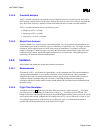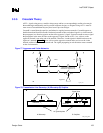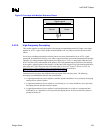
Intel
®
820E Chipset
R
Design Guide 153
3.3.3. Crosstalk Theory
AGTL+ signals swing across a smaller voltage range and have a correspondingly smaller noise margin
than technologies traditionally used in personal computer designs, so designers using AGTL+ must be
more aware of crosstalk than they may have been in previous designs.
Crosstalk is caused through capacitive and inductive coupling between networks. Crosstalk appears as
both backward and forward crosstalk. Backward crosstalk creates an induced signal in a victim network
that propagates in a direction opposite to that of the aggressor’s signal. Forward crosstalk creates a signal
that propagates in the same direction as the aggressor’s signal. On the AGTL+ bus, a driver on the
aggressor network is not at the end of the network. Therefore, it sends signals in both directions on the
aggressor’s network. Figure 77 shows a driver on the aggressor network and a receiver on the victim
network, neither of which is at a network end. The signal propagating in each direction causes crosstalk
on the victim network.
Figure 77. Aggressor and Victim Networks
Aggressor
Zo
Signal propagates in both
directions on aggressor line.
Zo
aggres_victim
Victim
Zo
Zo
Figure 78. Transmission Line Geometry: (A) Microstrip (B) Stripline
AC ground plane
A. Microstrip
B. Stripline
Dielectric,
ε
r
Signal lines
Signal lines
Dielectric,
ε
r
W
Sp
t
trans_line_geom


















